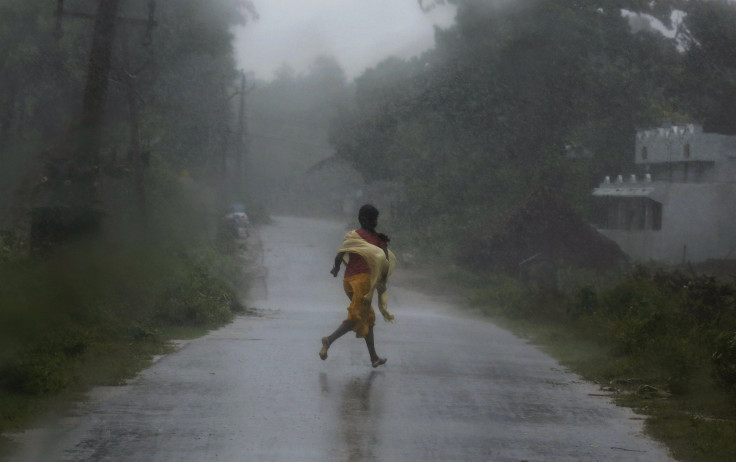Tropical Cyclone Phailin Makes Landfall In India, First Deaths Reported [PHOTOS]

Update 00:40 a.m. EDT Monday: The death toll from Cyclone Phailin, which struck India’s east coast states of Odisha and Andhra Pradesh over the weekend has climbed to 23, and all but two of the deaths were in Odisha, state officials said, The Hindu, a daily newspaper, reported.
According to the meteorological department, the storm has waned into “deep depression” and is passing over the neighboring states of Chhattisgarh, Bihar and Jharkhand. According to the Odisha government, more than 10 million people have been affected by the storm, which reportedly knocked down about a million houses.
A Panama-registered cargo ship carrying iron ore was reported to have sunk in rough seas off the coast of West Bengal, but the crew were rescued later by a Coast Guard aircraft.
Update 9:20 a.m. EDT Sunday: The death toll on India's east coast is 14, 13 in Odisha state and one in Andhra Pradesh, IBN Live reports. The army is working with state authorities to restore power.
Close to a million people were evacuated into shelters before the storm hit the shore with 125 mph (200 kph) winds. In 1999, a similar storm in the same region killed some 200,00 people, Reuters reported.
Original story:
Cyclone Phailin, a super cyclone that formed Oct. 9 over the Bay of Bengal, made landfall on Saturday in India’s Odisha state, the Times of India reported. Half a million people were evacuated as the powerful cyclone, with winds equivalent to those of a Category 4 storm on the Saffir-Simpson Hurricane Scale, barreled down on India’s coast. It is one of the largest evacuation operations in the history of India.
“The storm has the potential to cause huge damage,” L.S. Rathore, director general of the India Meteorological Department, told reporters, according to USA Today. Odisha is expected to get hit the hardest.
Spanning an area larger than France, Cyclone Phailin is reportedly one of the strongest storms to ever hit the Bay of Bengal. Police said several people were killed by falling trees in Odisha, but that the exact number of deaths caused by Phailin will not be known until Sunday.
“It has been raining very heavily here since yesterday, the streets are flooded, and electricity was shut down this morning,” A.K. Patnaik, a retired commodore in the Indian navy who is in Odisha’s capital city of Bhubaneswar, told USA Today. “The streets are empty, everyone is indoors, and people stocked up on groceries and essentials yesterday.”
People left coastal towns on bicycles and on foot. Authorities expect the storm surge alone to measure as much as 10 feet, according to NPR, and ocean water is projected to reach as far as 2,000 feet inland in the states of Odisha and Andhra Pradesh.
There are about 250 emergency shelters set up in government offices and schools to house people from low-lying coastal areas of Odisha, according to CNN. The India Meteorological Department warned that homes made of mud and bamboo, called kutcha, and older buildings are particularly vulnerable to the “very severe” storm.
Tropical Cyclone Phailin first developed as a tropical depression in the Gulf of Thailand on Oct. 4. Over the next few days, the system moved westward, passing over the Malay Peninsula, and it intensified through Friday.
The storm is particularly ominous because it reminds meteorologists of a powerful cyclone in 1999 that killed 10,000 people in Odisha.
According to BBC News, officials said they are better prepared to handle a cyclone of that nature this time around. The government has the army on standby in the two states -- Odisha and Andhra Pradesh -- for relief operations. Helicopters were also ready to deliver food packages to areas affected by the storm.
Still, the threat of the severe storm is being felt throughout the region. “Lot of people are going to die,” Kumudini Nanda, a resident of Bhubaneswar, told the International Business Times as translated from Odiya. “There are so many poor people here, and they can’t do anything to save themselves.”
© Copyright IBTimes 2024. All rights reserved.






















